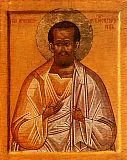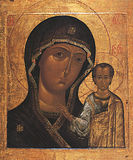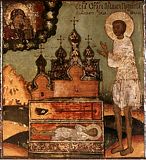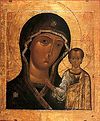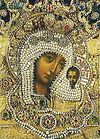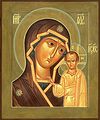

| Previous day | Next day |
| Old Style
July 8
|
Sunday |
New Style
July 21
|
| 4th Sunday after Pentecost. Tone 3. | No fast.
|
![]() Appearance of the Kazan Icon of the Most Holy Theotokos (1579).
Appearance of the Kazan Icon of the Most Holy Theotokos (1579). ![]() Great-martyr Procopius of Caesarea in Palestine, and with him Martyrs Theodosia (his mother), tribunes Antiochus and Nicostratus, and twelve women of senatorial rank (303).
Great-martyr Procopius of Caesarea in Palestine, and with him Martyrs Theodosia (his mother), tribunes Antiochus and Nicostratus, and twelve women of senatorial rank (303). ![]() St. Procopius, fool-for-Christ, wonderworker of Ustiug (Vologda) (1303).
St. Procopius, fool-for-Christ, wonderworker of Ustiug (Vologda) (1303).
Righteous Procopius, fool-for-Christ, of Ustya (Vologda) (ca. 1600). Synaxis of the Saints of the Pskov Caves Monastery.
Icons of the Most Holy Theotokos: weeping “Umileniye” (“Of Tender Feeling”) of Novgorod, and “Peschanskaya.” (1754)
Martyr Mirdat, King of Kartli, Georgia (410). Blessed King Edgar the Peaceable, of England (975). Martyrs Virgin Sunniva and companions, on Selje Island (Norway) (10th c.). St. Theophilus the Myrrh-gusher, of Pantocrator Monastery, Mt. Athos (1548). New Hieromartyr Anastasius, priest, of Constantinople (1743). Translation of the relics of St. Demetrius of Basarabov, Bulgaria, to Bucharest (1774).
Slaying of Anastasia Strogilos on the Mount of Olives (1995).
Thoughts for Each Day of the Year
According to the Daily Church Readings from the Word of God
By St. Theophan the Recluse

Fourth Sunday After Pentacost. [Rom. 6:18-23; Matt. 8:5-13]
What faith the centurion has! The Lord Himself marvelled. The essence of this faith is that he confessed the Lord to be the God of all things, an all-powerful sovereign and master of all that exists; for this reason he beseeched, speak the word only, and my servant shall be healed. I believe that everything is under Your authority and everything obeys Your slightest beckoning. The Lord requires the same faith of us, as well. He who has this faith knows no lack, and whatsoever he asks, he receives. Thus has the Lord Himself promised. Oh, when will we have if only a little of such faith! But this faith is also a gift; we must ask for it as well, and ask for it with faith. Let us ask for it, with a feeling of need for it, ask for it continually, fervently, at the same time aiding its unfolding within us through corresponding thoughts, and most of all by submitting to God’s commandments.
Articles
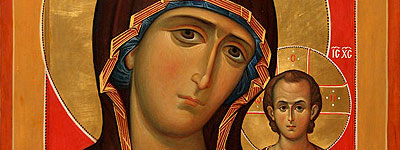 Kazan Icon of the Mother of God |
 The Kazan Icon of the Mother of GodNadezhda DmitrievaThe Kazan Icon of the Mother of God enjoys unparalleled veneration in Russia. |
 Greatmartyr Procopius of Caesarea, in PalestineThe Holy Great Martyr Procopius, in the world Neanius, a native of Jerusalem, lived and suffered during the reign of the emperor Diocletian (284-305). |
